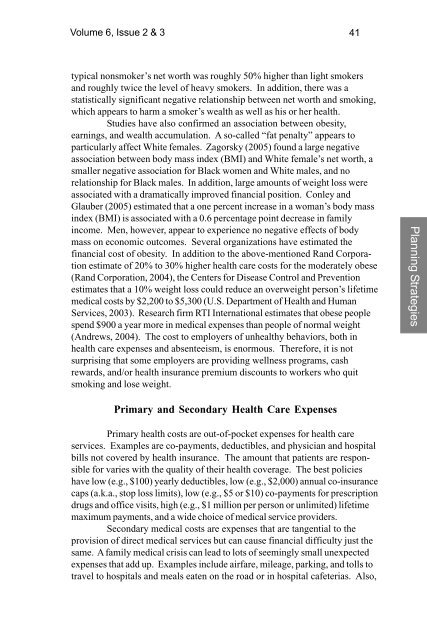3433-vol. 6 issue 2-3.pmd - iarfc
3433-vol. 6 issue 2-3.pmd - iarfc
3433-vol. 6 issue 2-3.pmd - iarfc
Create successful ePaper yourself
Turn your PDF publications into a flip-book with our unique Google optimized e-Paper software.
Volume 6, Issue 2 & 3 41<br />
typical nonsmoker’s net worth was roughly 50% higher than light smokers<br />
and roughly twice the level of heavy smokers. In addition, there was a<br />
statistically significant negative relationship between net worth and smoking,<br />
which appears to harm a smoker’s wealth as well as his or her health.<br />
Studies have also confirmed an association between obesity,<br />
earnings, and wealth accumulation. A so-called “fat penalty” appears to<br />
particularly affect White females. Zagorsky (2005) found a large negative<br />
association between body mass index (BMI) and White female’s net worth, a<br />
smaller negative association for Black women and White males, and no<br />
relationship for Black males. In addition, large amounts of weight loss were<br />
associated with a dramatically improved financial position. Conley and<br />
Glauber (2005) estimated that a one percent increase in a woman’s body mass<br />
index (BMI) is associated with a 0.6 percentage point decrease in family<br />
income. Men, however, appear to experience no negative effects of body<br />
mass on economic outcomes. Several organizations have estimated the<br />
financial cost of obesity. In addition to the above-mentioned Rand Corporation<br />
estimate of 20% to 30% higher health care costs for the moderately obese<br />
(Rand Corporation, 2004), the Centers for Disease Control and Prevention<br />
estimates that a 10% weight loss could reduce an overweight person’s lifetime<br />
medical costs by $2,200 to $5,300 (U.S. Department of Health and Human<br />
Services, 2003). Research firm RTI International estimates that obese people<br />
spend $900 a year more in medical expenses than people of normal weight<br />
(Andrews, 2004). The cost to employers of unhealthy behaviors, both in<br />
health care expenses and absenteeism, is enormous. Therefore, it is not<br />
surprising that some employers are providing wellness programs, cash<br />
rewards, and/or health insurance premium discounts to workers who quit<br />
smoking and lose weight.<br />
Planning Strategies<br />
Primary and Secondary Health Care Expenses<br />
Primary health costs are out-of-pocket expenses for health care<br />
services. Examples are co-payments, deductibles, and physician and hospital<br />
bills not covered by health insurance. The amount that patients are responsible<br />
for varies with the quality of their health coverage. The best policies<br />
have low (e.g., $100) yearly deductibles, low (e.g., $2,000) annual co-insurance<br />
caps (a.k.a., stop loss limits), low (e.g., $5 or $10) co-payments for prescription<br />
drugs and office visits, high (e.g., $1 million per person or unlimited) lifetime<br />
maximum payments, and a wide choice of medical service providers.<br />
Secondary medical costs are expenses that are tangential to the<br />
provision of direct medical services but can cause financial difficulty just the<br />
same. A family medical crisis can lead to lots of seemingly small unexpected<br />
expenses that add up. Examples include airfare, mileage, parking, and tolls to<br />
travel to hospitals and meals eaten on the road or in hospital cafeterias. Also,
















